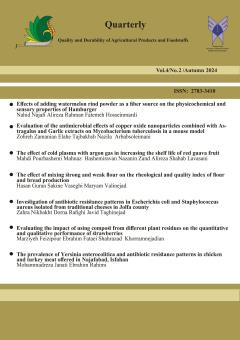The effect of mixing strong and weak flour on the rheological and quality index of flour and bread production
Subject Areas : Shelf Life of Food Products and Agricultural ProductionsHasan Guran 1 , Sakine Vaseghi 2 , Maryam Valinejad 3
1 - M.Sc., Department of Agriculture and Natural Science, Savadkooh Branch, Islamic Azad University, Savadkooh, Iran
2 - Assistant professor, Department of Agriculture and Natural Science, Savadkooh Branch, Islamic Azad University, Savadkooh, Iran
3 - Assistant professor, Department of Agriculture and Natural Science, Savadkooh Branch, Islamic Azad University, Savadkooh, Iran
Keywords: Flour quality, Flour mixing, Weak flour, Strong flour,
Abstract :
Flour and bread make up a large part of the table and diet of Iranians. However, the weakness of wheat production in the country is one of the constant problems of the flour and bread industry, which has caused many problems in this industry, and flour mixing is always implemented as the main solution. In the present study, the mixing of strong flour with weak flour in different proportions and its effect on the quality indicators of flour and bread production were investigated. First, samples of 18% flour from the Sardari wheat variety, which is a weak wheat variety, were prepared and in the ratios of 20-80, 30-70, 50-50, 30-70% and 20-80 with 18% flour and strong wheat sample of variety 19. 80N-mixed and rheological and quality indicators (including wet gluten percentage, dry gluten percentage, gluten index, Zelny test, Falling number, ash percentage, moisture percentage, measurement of flour color with image processing technique) And the results showed that the treatment of mixing 70% of weak flour with 30% of strong flour due to the high level of all indicators related to flour and bread, including dry and wet gluten percentage, gluten index, Zelani and Falling number, ash percentage, moisture and protein, texture, aroma and smell, chewability, porosity, appearance and color indicators of bread, compared to other mixes, and also no significant difference compared to mixes with a higher percentage of strong flour can be suggested as the best mix.
1- Cui T, Zhou X, Sui W, Liu R, Wu T, Wang S, Jin Y, Zhang M. Effects of thermal-induced konjac glucomannan-protein interaction on structural and rheological properties of wheat dough. Food Structure. 2022; 33:100288.
2- Amini M, Afshin Pajoh R, Jamali V. Investigating the effect of thermal process on the rheological properties of dough. 21st National Food Industry Congress.2012. (In Persian)
3- Bahrami, M. Shahedi. The Effect of Wheat Cultivar, Flour Extraction Rate and Baking Duration and Temperature on Dough Rheological Properties, Bread Staling and Organoleptic Properties. Journal of Crop Production and Processing 2004; 8 (1):195-204.
4- Nasehi B, Tahanejad M. Characteristics of the chemical, sensory and microbial of the flours in Khuzestan. Journal of food science and industry. 2014; 11(45): 77-84. (In Persian).
5- Sahraiyan B, Mazaheri Tehrani M, Naghipour F, Ghiafeh Davoodi M, Soleimani M. The effect of mixing wheat flour with rice bran and soybean flour on physicochemical and sensory properties of baguettes. Iranian Journal of Nutrition Sciences and Food Technology. 2013; 8 (3):229-240. (In Persian).
6- Mirmajidi A, and Abbasi S.Effect of Wheat Cultivar and Wheat Flour Ratio on Physicochemical Properties of Samanoo, Journal of Agricultural Engineering Research, 2012; 13(1):56-45. (In Persian).
7- Poursafar L, Peighambardoust S.H, Alizadeh Shalchi L, Shakuoie Bonab E, Rafat S.A. Effect of the temperature and time of flour heat treatment on the quality characteristics of sponge cake, Electronic Journal of Food Processing and Preservation.2011; 2 (4): 87-104(In Persian).
8- De Bondt Y, Hermans W, Moldenaers P, Courtin CM. Selective modification of wheat bran affects its impact on gluten-starch dough rheology, microstructure and bread volume. Food Hydrocolloids. 2021; 113:106348.
9- Raftani AZ, Shamshirsaz M. Improve the quality of wheat flour by determination of mixing ratio of Morvarid (Kordkoy area) and Bezostaya wheat varieties. Food Science and Technology;2017;14(3): 339-346. (In Persian).
10- Apichartsrangkoon A, Bell A, Ledward D, Schofield JD. Dynamic Viscoelastic Behavior of High-Pressure-Treated Wheat Gluten. Cereal Chemistry. 1999; 76. 10.1094/CCHEM.1999.76.5.777.
11- Niu M, Hou G, Lee G, Chen Z, Effects of fine grinding of millfeeds on the quality attributes of reconstituted whole-wheat flour and its raw noodle products. LWT - Food Science and Technology.2014: 57. 58-64.
12- Marti A, Torri L, Casiraghi M C, Franzetti, L., Limbo S, Morandin F, Quaglia L, Pagani MA. Wheat germ stabilization by heat-treatment or sourdough fermentation: Effects on dough rheology and bread properties. LWT - Food Science and Technology.2014: 59 (2): 1100-1106.
13- Yazar, G. Wheat Flour Quality Assessment by Fundamental Non-Linear Rheological Methods: A Critical Review. Foods 2023; 12(18):3353.
14- Cappelli A, Bettaccini L, Cini E. The kneading process: A systematic review of the effects on dough rheology and resulting bread characteristics, including improvement strategies. Trends in Food Science & Technology. 2020; 104:91-101.
15- Sun X, Wu S, Koksel F, Xie M, Fang Y. Effects of ingredient and processing conditions on the rheological properties of whole wheat flour dough during breadmaking-A review.
16- Food Hydrocolloids. 2023; 135:108123.


